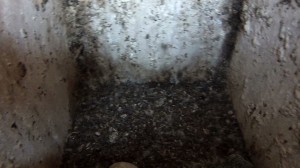Kestrels at Gwynedd Preserve
By Ronald Zigler, volunteer at Gwynedd Preserve
All bird photos are the property of Ron Zigler and were used with permission.
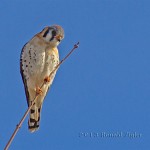
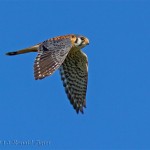 My interest in Kestrels emerged from an interest in both birding and my hobby of bird photography. Kestrels are the smallest and most colorful raptor of America and are part of the “family” of birds known as “falcons.” They are about the size of a Blue Jay, but very difficult to approach and, hence, rather challenging to photograph. While sometimes called a “Sparrow Hawk” Kestrels are more closely related to the Peregrine Falcon than to the smaller members of the hawk family. In many ways, “Sparrow Hawk” is a misnomer since their diet consists almost overwhelmingly of insects. However, Kestrels will hunt small mammals as well as toads or lizards. On occasion, they may take a small bird if the opportunity presents itself. One of the photos I was able to capture of a male Kestrel at the Gwynedd Preserve this spring shows him on the top of a fence post with a vole. Kestrels need to supplement their diets with these small mammals during the winter months when insects are not available.
My interest in Kestrels emerged from an interest in both birding and my hobby of bird photography. Kestrels are the smallest and most colorful raptor of America and are part of the “family” of birds known as “falcons.” They are about the size of a Blue Jay, but very difficult to approach and, hence, rather challenging to photograph. While sometimes called a “Sparrow Hawk” Kestrels are more closely related to the Peregrine Falcon than to the smaller members of the hawk family. In many ways, “Sparrow Hawk” is a misnomer since their diet consists almost overwhelmingly of insects. However, Kestrels will hunt small mammals as well as toads or lizards. On occasion, they may take a small bird if the opportunity presents itself. One of the photos I was able to capture of a male Kestrel at the Gwynedd Preserve this spring shows him on the top of a fence post with a vole. Kestrels need to supplement their diets with these small mammals during the winter months when insects are not available.
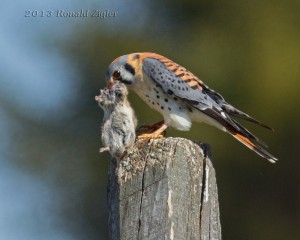
Some, but not all Kestrels will migrate south during the winter. Often a male Kestrel will remain in the territory of his established nest and defend his territory year round. Early in the spring when I began observing the Kestrels at the Gwynedd Preserve, I often noticed the male perched on his nest box. It was not until later that I observed a female Kestrel who had dropped by to inspect the nest box. It looked as if he was trying to impress her with the new nest box that had been set up there.
Kestrels adapt well to man-made nest boxes since they are cavity nesters. They do not create their own cavities, however, and have traditionally nested in tree cavities. In the 1990s, there emerged a growing effort to set up nest boxes for Kestrels in order to compensate for the development that had reduced their traditional nesting sites, which resulted in a drop in their population. By the end of the 90s, the birds began to rebound as they proved themselves highly adaptable to these nest boxes. However they do often compete with Screech Owls and Starlings for these sites.
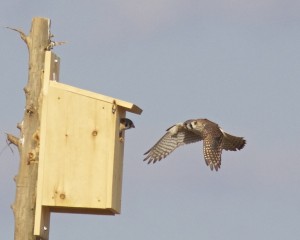
While Kestrels are not endangered, their numbers have once again declined somewhat in recent years. The reason for the decline is not clear. This is, however, one of the reasons why the American Kestrel Partnership was established—to set up and monitor Kestrel nest boxes so that we may help wildlife biologists around the country collect data on both successful as well as unsuccessful nest boxes.
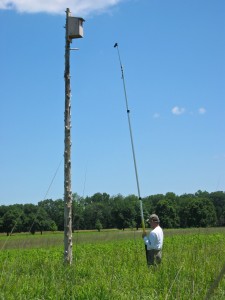
Gwynedd Preserve Manager Tom Kershner took this photo of me using an infrared camera mounted on a pole to monitor the Kestrel nest
Photo: Ron Zigler
The Partnership has emphasized that much is learned from either outcome. Unsuccessful nest boxes can help researchers understand the threats that Kestrels are encountering. This spring, the Kestrels at Gwynedd were clearly successful, and the activity, which was monitored, was typical of their mating cycle. Usually, 4 to 6 eggs are laid around the end of April or early May (the Gwynedd nest box had 5 eggs, but only 4 hatched).
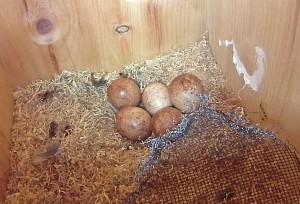
The eggs are then incubated for about 28 days after which the nestlings will hatch.
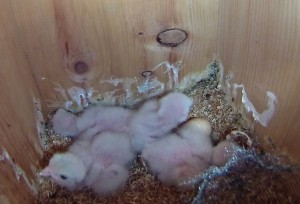
Another 28 or 30 days later, the young birds will fledge, looking like somewhat smaller adult birds with the distinctive plumage of the male and female Kestrel.
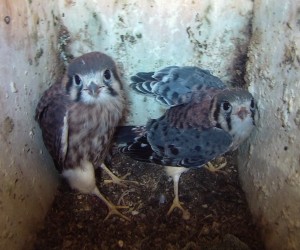
Next year, we plan on having a second nest box set up the recommended one half mile away from the nest box that was occupied this year. We look forward to increasing this bird’s presence on the preserve all year long.
